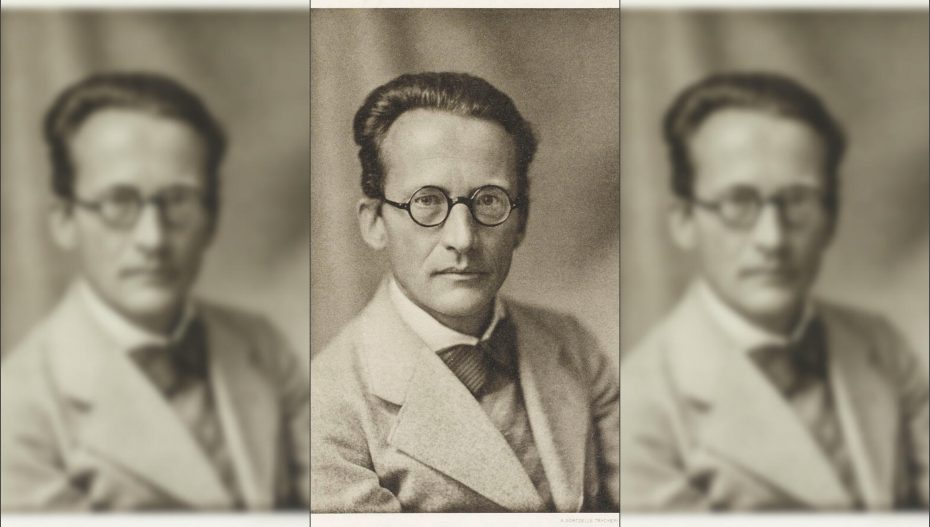Erwin Schrödinger, 1933. Photo: Nobel Foundation/Public Domain.
Quantum physics is one of the most remarkable developments of the 20th century. Until the early 1900s or so, Isaac Newton’s laws of motion dominated the study of the physical universe. They were later ‘upgraded’, for the most part, by Albert Einstein’s theories of relativity, and together, they could satisfactorily explain almost all physical phenomena. These classical theories formed the bedrock on which the entire superstructure of physics rested.
But in the early 1900s, physicists found that subatomic particles like electrons could behave in ways that defied the predictions of classical physics. To explain this behaviour, they formulated the theories and principles of quantum mechanics – together a set of natural laws that could predict the behaviour of electrons and other subatomic particles very well.
Some of the more well-known among these physicists were Einstein, Niels Bohr, Erwin Schrödinger and Werner Heisenberg. However, these physicists and others would soon find that the newcomer, while opening new theoretical and technological vistas, also made some strange predictions. For example, it allowed electrons to tunnel through walls, particles to exist simultaneously in two places at once, black holes to evaporate, and information to be exchanged between observers faster than light.
This was a crucial moment in history, when physics was in a state of major upheaval. The familiar classical picture of reality was being disrupted by one that seemed to be too crazy to be true, even as it explained numerous experimental observations that the former could not. Einstein, Bohr, Schrödinger, Heisenberg and others were deeply troubled by its implications. Indeed, they were faced with a personal dilemma: to believe a preposterous theory that worked or discard it for an intuitive theory that didn’t work.
At this critical juncture, they discovered that their notion, that the world we see is not reality itself but a projection onto our consciousness, wasn’t completely new. In the ancient Indian texts known as the Upanishads, they found echoes of their theories, and a philosophical foundation to ensure they would no longer be cast adrift by the implications of quantum mechanics.
A strange world

Quantum physics took shape through several counterintuitive discoveries regarding the inconsistent behaviour of light. James Maxwell showed in 1865 that light could be modelled as electromagnetic waves. In 1905, Albert Einstein published his paper on the photoelectric effect, where he proposed that light is composed of tiny massless particles called photons. Louis de Broglie, a French aristocrat, unified these views in 1924 with a bold suggestion that all matter exhibits wave-like behaviour. This proposition, known as the wave-particle duality, opened up a Pandora’s box of arguments that challenge the nature of reality, even its very existence.
According to classical physics, microscopic particles like electrons are solid spherical balls of matter. Quantum physics replaces this picture with something alien to our sensibilities. It says that rather than being in one place, an electron is located in a diffuse cloud of probabilities. If you try to observe the electron, there is a higher probability that you will find it in a denser region of the cloud than a sparser region.
This cloud is represented mathematically by the wave function. And at the heart of quantum physics is an equation that governs how a wave function evolves as time passes. The Austrian-Irish physicist Erwin Schrödinger arrived at it in 1926, and so it’s called the Schrödinger’s equation.
Science writers revel in portraying the tension between the reality described by quantum physics and the reality we perceive through our senses. Since macroscopic objects like trees and cars are composed of microscopic particles like atoms and molecules, which in turn also behave like waves, macroscopic objects should also behave like waves. But this is not what we experience. The computer on which I wrote this article and the device on which you are reading it surely don’t feel like waves!
So when does something stop behaving like a wave and start behaving like a piece of matter, an object composed strictly of particles? Surprisingly, this happens when we observe it.
According to the Copenhagen interpretation of quantum mechanics, observing an object causes it to lose its quantum nature and collapse into the classical form we’re used to. This collapse of the wave function implies that the reality we see exists only when we are there to observe it. And an observer does not merely observe reality; she creates it.
If left to themselves, things would remain as waves until somebody observed them. Einstein, who could not reconcile himself with this, summed up the strangeness of quantum physics when he asked a friend, “Do you believe the Moon exists only when I look at it?”
Subjective reality of the Upanishads

The Upanishads are a collection of Sanskrit texts transmitted orally from teacher to student over thousands of years. While the Vedas prescribe rituals to appease deities, the Upanishads are concerned with the nature of reality, mind and the self.
Schrödinger was fascinated by this thought. According to Subhash Kak’s book The Wishing Tree (2008), Schrödinger named his dog Atman, and his conference talks would, by one account, often end with the statement ‘Atman=Brahman’, that he would call – somewhat self-aggrandisingly – the second Schrödinger’s equation. When his affair with the Irish artist Sheila May ended, she wrote him a letter that alluded to this fascination: “I looked into your eyes and found all life there, that spirit which you said was no more you or me, but us, one mind, one being … you can love me all your life, but we are two now, not one.”
Quantum physics eliminates the gap between the observer and the observed. The Upanishads say that the observer and the observed are the same things. In his 1944 book What is Life?, Schrödinger took on a peculiar line of thought. If the world is indeed created by our act of observation, there should be billions of such worlds, one for each of us. How come your world and my world are the same? If something happens in my world, does it happen in your world, too? What causes all these worlds to synchronise with each other?
He found his answer, again, in the Upanishads. “There is obviously only one alternative,” he wrote, “namely the unification of minds or consciousnesses. Their multiplicity is only apparent, in truth there is only one mind. This is the doctrine of the Upanishads.”

According to the Upanishads, Brahman alone exists. Everything we see around us is Maya, a distortion of the Brahman caused due to our ignorance and imperfect senses. The Chandogya Upanishad says, “All this is Brahman. Everything comes from Brahman, everything goes back to Brahman, and everything is sustained by Brahman.”

The Upanishads describe how reality arises out of consciousness. But consciousness cannot be found inside our bodies as a substance or an organ. In that case, how can a non-material consciousness interact with and control our material bodies? Exactly where does mind interact with matter? This question is known as the mind-body problem, and has vexed philosophers for a long time.
Since we haven’t been able to locate or explain this interaction, we’re left with a deceptively simple choice: either consciousness or reality doesn’t exist.
Most exponents of modern science today lean towards the materialist view – that consciousness is a byproduct of the neurochemical processes occurring in our brain. It depends on these processes and cannot exist without them.
On the other hand, the Upanishads uphold an idealist view – that consciousness exists by itself, and that the physical world depends on it. There is no objective reality that exists independently of the observer. Schrödinger supported this view and lamented the aversion for it: “it must be said that to Western thought this doctrine has little appeal, it is unpalatable, it is dubbed fantastic, unscientific. Well, so it is because our science – Greek science – is based on objectivation, whereby it has cut itself off from an adequate understanding of the subject of cognisance, of the mind.”
So the mind-body problem, he wrote, “is our fruitless quest for the place where mind acts on matter or vice-versa … The material world has only been constructed at the price of taking the self, that is, mind, out of it, removing it; mind is not part of it; obviously, therefore, it can neither act on it nor be acted on by any of its parts.”
Physicists and Upanishads

Schrödinger was moved by the Upanishads. He discussed it with everyone he met and made determined efforts to incorporate it in his life. The epitaph on his tombstone reads, “… So all Being is an one and only Being; And that it continues to be when someone dies; [this] tells you, that he did not cease to be.”
And he wasn’t alone. Niels Bohr had famously said, “I go to the Upanishad to ask questions.” In The Tao of Physics (1975), Fritjof Capra wrote of the time Heisenberg met Rabindranath Tagore, and that the “introduction to Indian thought brought Heisenberg great comfort.”
J. Robert Oppenheimer, who led the Manhattan Project to develop the world’s first nuclear weapons, learned Sanskrit so he could read the Bhagavad Gita in its original form. When he witnessed the first atom bomb explode, he famously recalled a verse from the Gita, where Krishna shows Arjuna his true form. He translated the verse into English thus: “Now I am become death, the destroyer of worlds.”
The Upanishads provided solace – a conception of reality and the universe based on observation and reasoning. In the precepts of these texts, the physicists found moral comfort, intellectual courage and spiritual guidance.
Nothing attests to the importance of these philosophical edifices less than absurd claims that Schrödinger and other scientists merely baked the lessons of the Upanishads into quantum theory. Such statements are misleading through and through. Schrödinger was, foremost, a physicist deeply entrenched in the methods of science. Indian philosophy soothed his soul but it is unlikely that it helped him frame mathematical equations.
Indeed, Schrödinger was often critical of many Indian ideas and pointed out that they were prone to superstition. Modern science, according to him, represented the zenith of human thought. He sought Indian philosophy not to replace the methods of science but to be inspired. He was aware that mixing two systems of thought separated by thousands of years was not easy. He believed Western thought needed to borrow ideas from Indian philosophy – with great care. As he wrote,
“I do believe that this is precisely the point where our present way of thinking does need to be amended, perhaps by a bit of blood-transfusion from Eastern thought. That will not be easy, we must beware of blunders — blood-transfusion always needs great precaution to prevent clotting. We do not wish to lose the logical precision that our scientific thought has reached, and that is unparalleled anywhere at any epoch.”
Apart from philosophy, Indian thinkers have made vital scientific contributions to astronomy, mathematics, literature, law, biology, psychology and most other realms of human endeavour, if not all of them. They often do not receive the recognition due them. However, these instances of overlooking – no matter how severe – can never be corrected by attributing dubious achievements to these or other Indians.
The Upanishads themselves preach a message of unity and are opposed to any form of discrimination. To adapt the words of the Isha Upanishad, “Who sees all beings in their own self and their own self in all beings, loses all hatred and fear.”
This article is written by Viraj Kulkarni and was first published by The Wire. Viraj Kulkarni has a master’s degree in computer science from UC Berkeley and is currently pursuing a PhD in artificial intelligence.













